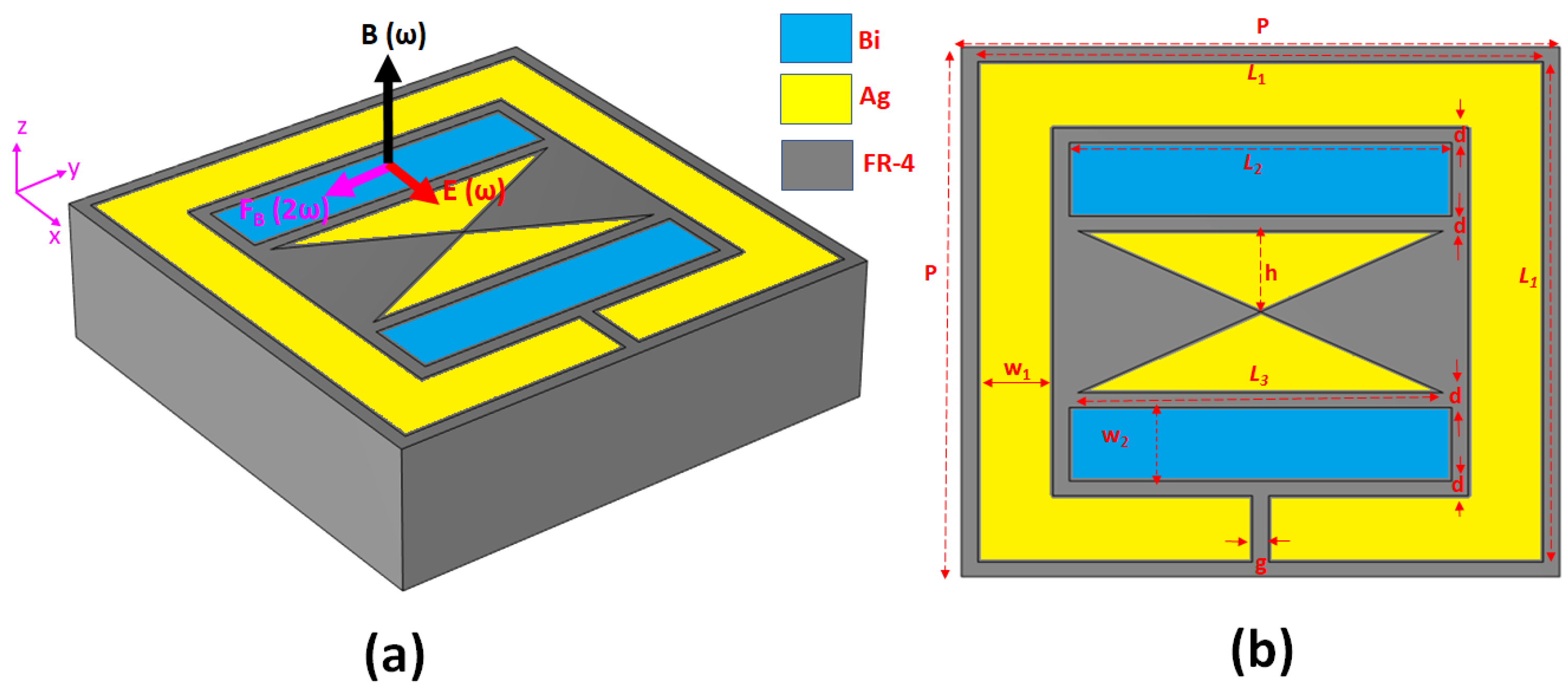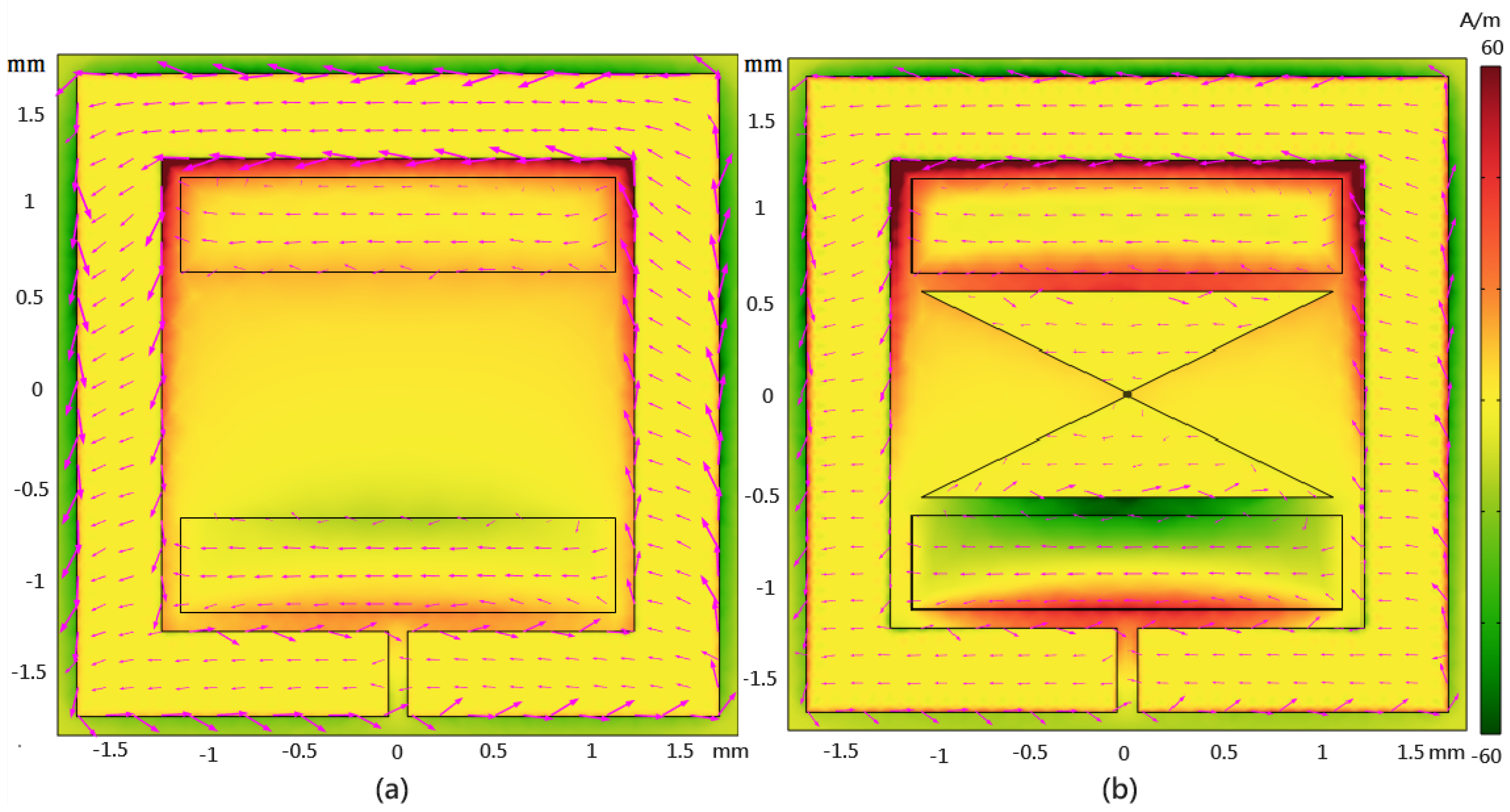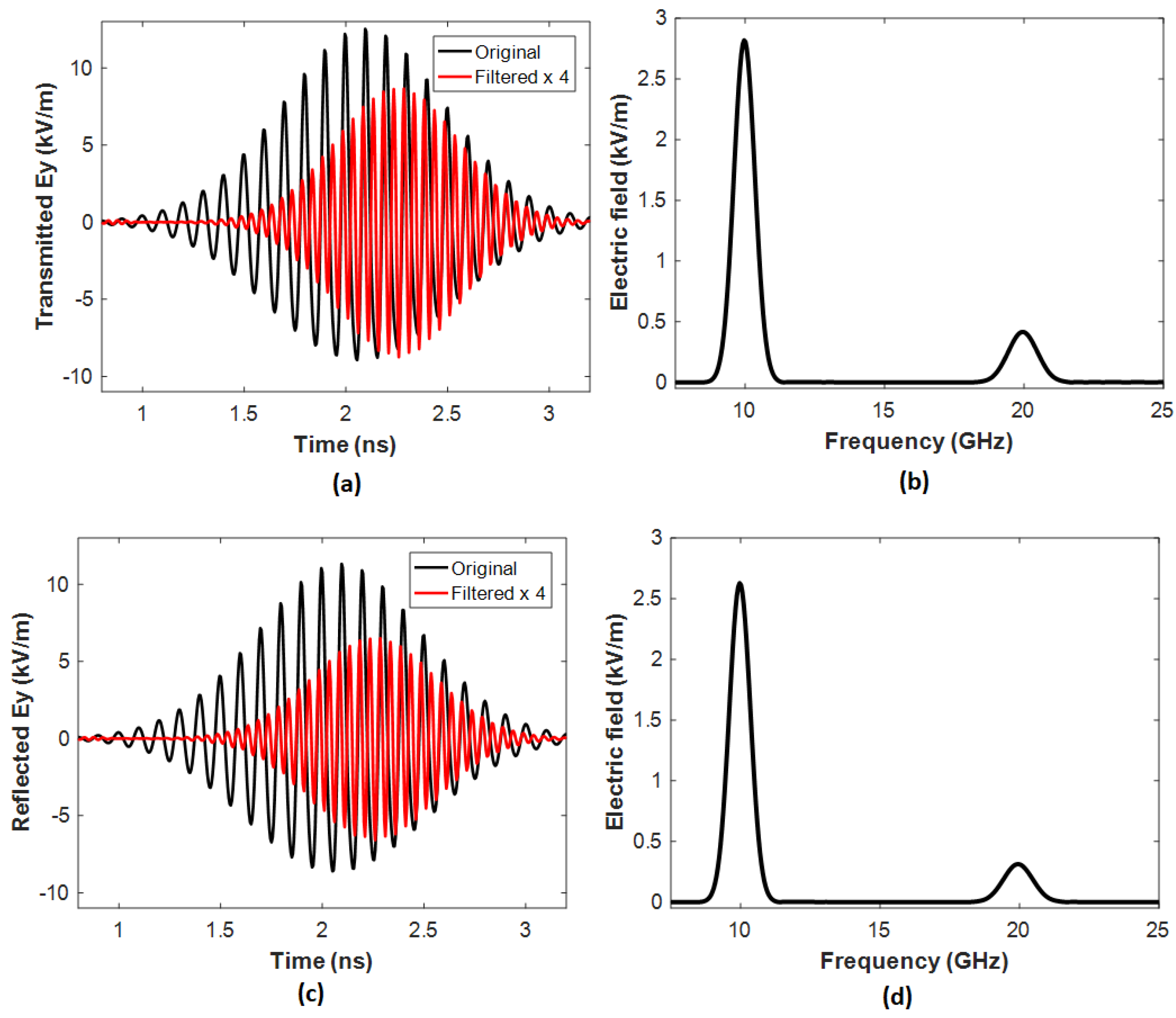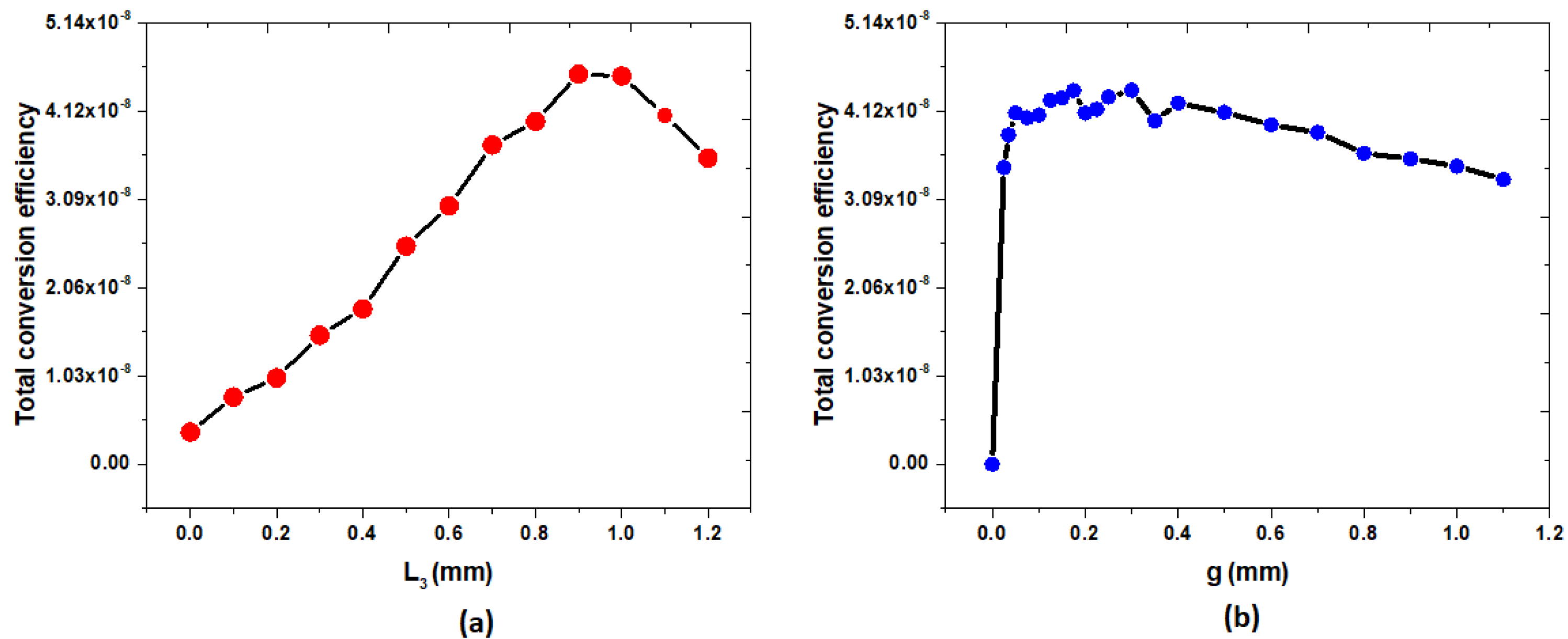Boosting Second Harmonic Generation Efficiency and Nonlinear Susceptibility via Metasurfaces Featuring Split-Ring Resonators and Bowtie Nanoantennas
Abstract
:1. Introduction
2. Materials and Methods
3. Results
3.1. Frequency Domain Results
3.2. Time Domain Results
4. Conclusions
Funding
Data Availability Statement
Acknowledgments
Conflicts of Interest
References
- Liu, B.; Song, K.; Xiao, J. Two-Dimensional Optical Metasurfaces: From Plasmons to Dielectrics. Adv. Condens. Matter Phys. 2019, 2019, 2329168. [Google Scholar] [CrossRef]
- Long, A.; Xie, Z.; Wu, H.; Zeng, Q.; Zhong, P.; Liu, J.; Ye, H.; Fan, D.; Chen, S. Switchable optical differentiator using Fano resonance metasurface. Opt. Commun. 2024, 550, 129954. [Google Scholar] [CrossRef]
- Liu, J.; Guan, C.; Chen, H.; Liu, B.; Cheng, T.; Yang, J.; Shi, J.; Yuan, L. Dual-core optical fiber tweezers based on all-dielectric metasurface. Opt. Commun. 2023, 531, 129232. [Google Scholar] [CrossRef]
- Zhou, C.-D.; Lu, P.; Yue, Z.; Xu, J.; Teng, S. Polarization-Encoded Structured Light Generation Based on Holographic Metasurface. Plasmonics 2023, 18, 653–659. [Google Scholar] [CrossRef]
- Yao, J.; Lin, R.; Chen, M.K.; Tsai, D.P. Integrated-resonant metadevices: A review. Adv. Photonics 2023, 5, 024001. [Google Scholar] [CrossRef]
- Ullah, N.; Zhao, R.; Huang, L. Recent Advancement in Optical Metasurface: Fundament to Application. Micromachines 2022, 13, 1025. [Google Scholar] [CrossRef] [PubMed]
- Fan, Y.; Yao, J.; Tsai, D.P. Advance of large-area achromatic flat lenses. Light Sci. Appl. 2023, 12, 51. [Google Scholar] [CrossRef]
- Tang, D.; Wang, C.; Zhao, Z.; Wang, Y.; Pu, M.; Li, X.; Gao, P.; Luo, X. Ultrabroadband superoscillatory lens composed by plasmonic metasurfaces for subdiffraction light focusing. Laser Photonics Rev. 2015, 9, 713–719. [Google Scholar] [CrossRef]
- Su, V.-C.; Chu, C.H.; Sun, G.; Tsai, D.P. Advances in optical metasurfaces: Fabrication and applications [Invited]. Opt. Express 2018, 26, 13148–13182. [Google Scholar] [CrossRef] [PubMed]
- Kim, K.-H. Asymmetric Second-Harmonic Generation with High Efficiency from a Non-chiral Hybrid Bilayer Complementary Metasurface. Plasmonics 2021, 16, 77–82. [Google Scholar] [CrossRef]
- Wang, X.; Wang, X.; Xin, J.; Li, J.; Ren, Q.; Cai, H.; Lang, Y.; Lan, Z.; Jia, Y.; Jin, R.; et al. Tailoring the bound states in the multi-channel nonlinear plasmonic metasurfaces. Opt. Commun. 2023, 549, 129834. [Google Scholar] [CrossRef]
- Zheludev, N.I.; Kivshar, Y.S. From metamaterials to metadevices. Nat. Mater. 2012, 11, 917–924. [Google Scholar] [CrossRef] [PubMed]
- Neufeld, O.; Cohen, O. Optical Chirality in Nonlinear Optics: Application to High Harmonic Generation. Phys. Rev. Lett. 2018, 120, 133206. [Google Scholar] [CrossRef]
- Li, G.; Zhang, S.; Zentgraf, T. Nonlinear photonic metasurfaces. Nat. Rev. Mater. 2017, 2, 17010. [Google Scholar] [CrossRef]
- Krasnok, A.; Tymchenko, M.; Alù, A. Nonlinear metasurfaces: A paradigm shift in nonlinear optics. Mater. Today 2018, 21, 8–21. [Google Scholar] [CrossRef]
- Franken, P.A.; Hill, A.E.; Peters, C.W.; Weinreich, G. Generation of Optical Harmonics. Phys. Rev. Lett. 1961, 7, 118–119. [Google Scholar] [CrossRef]
- Chou Chau, Y.-F. Enhancing imaging capabilities with a high-sensitivity multichannel optical filter. Micro Nanostructures 2024, 186, 207732. [Google Scholar] [CrossRef]
- Chou Chau, Y.-F. Multiple-Mode Bowtie Cavities for Refractive Index and Glucose Sensors Working in Visible and Near-infrared Wavelength Ranges. Plasmonics 2021, 16, 1633–1644. [Google Scholar] [CrossRef]
- Visser, D.; Basuvalingam, S.B.; Désières, Y.; Anand, S. Optical properties and fabrication of dielectric metasurfaces based on amorphous silicon nanodisk arrays. Opt. Express 2019, 27, 5353–5367. [Google Scholar] [CrossRef] [PubMed]
- Chou Chau, Y.-F.; Lim, C.M.; Chiang, C.-Y.; Voo, N.Y.; Muhammad Idris, N.S.i.; Chai, S.U. Tunable silver-shell dielectric core nano-beads array for thin-film solar cell application. J. Nanoparticle Res. 2016, 18, 88. [Google Scholar] [CrossRef]
- Rocco, D.; Camacho Morales, R.; Xu, L.; Zilli, A.; Vinel, V.; Finazzi, M.; Celebrano, M.; Leo, G.; Rahmani, M.; Jagadish, C.; et al. Second order nonlinear frequency generation at the nanoscale in dielectric platforms. Adv. Phys. X 2022, 7, 2022992. [Google Scholar] [CrossRef]
- Yao, J.; Yin, Y.; Ye, L.; Cai, G.; Liu, Q. Enhancing third-harmonic generation by mirror-induced electric quadrupole resonance in a metal–dielectric nanostructure. Opt. Lett. 2020, 45, 5864. [Google Scholar] [CrossRef] [PubMed]
- Zubyuk, V.; Carletti, L.; Shcherbakov, M.; Kruk, S. Resonant dielectric metasurfaces in strong optical fields. APL Mater. 2021, 9, 060701. [Google Scholar] [CrossRef]
- Gonçalves, M.R.; Minassian, H.; Melikyan, A. Plasmonic resonators: Fundamental properties and applications. J. Phys. D Appl. Phys. 2020, 53, 443002. [Google Scholar] [CrossRef]
- Shaoxin, S.; Meng, L.; Zhang, Y.; Han, J.; Ma, Z.; Hu, S.; He, Y.; Li, J.; Ren, B.; Shih, T.-M.; et al. Plasmon-Enhanced Second-Harmonic Generation Nanorulers with Ultrahigh Sensitivities. Nano Lett. 2015, 15, 6716–6721. [Google Scholar] [CrossRef]
- Bonacina, L.; Brevet, P.-F.; Finazzi, M.; Celebrano, M. Harmonic generation at the nanoscale. J. Appl. Phys. 2020, 127, 230901. [Google Scholar] [CrossRef]
- Liu, Y.; Zhu, S.; Zhou, Q.; Cao, Y.; Fu, Y.; Gao, L.; Chen, H.; Xu, Y. Enhanced third-harmonic generation induced by nonlinear field resonances in plasmonic-graphene metasurfaces. Opt. Express 2020, 28, 13234–13242. [Google Scholar] [CrossRef] [PubMed]
- Hou, Y.; Li, J.; Li, B.; Yuan, Q.; Gan, W. Combined Second Harmonic Generation and Fluorescence Analyses of the Structures and Dynamics of Molecules on Lipids Using Dual-Probes: A Review. Molecules 2022, 27, 3778. [Google Scholar] [CrossRef]
- Chou Chao, C.-T.; Chou Chau, Y.-F. Enhancing second harmonic generation efficiency and effective nonlinear susceptibility via metasurfaces employing split-ring resonators. Opt. Commun. 2024, 562, 130568. [Google Scholar] [CrossRef]
- Boroviks, S.; Kiselev, A.; Achouri, K.; Martin, O.J.F. Demonstration of a Plasmonic Nonlinear Pseudodiode. Nano Lett. 2023, 23, 3362–3368. [Google Scholar] [CrossRef]
- Celebrano, M.; Wu, X.; Baselli, M.; Großmann, S.; Biagioni, P.; Locatelli, A.; De Angelis, C.; Cerullo, G.; Osellame, R.; Hecht, B.; et al. Mode matching in multiresonant plasmonic nanoantennas for enhanced second harmonic generation. Nat. Nanotechnol. 2015, 10, 412–417. [Google Scholar] [CrossRef] [PubMed]
- Schlickriede, C.; Waterman, N.; Reineke, B.; Georgi, P.; Li, G.; Zhang, S.; Zentgraf, T. Imaging through Nonlinear Metalens Using Second Harmonic Generation. Adv. Mater. 2018, 30, 1703843. [Google Scholar] [CrossRef]
- Klein, M.W.; Enkrich, C.; Wegener, M.; Linden, S. Second-Harmonic Generation from Magnetic Metamaterials. Science 2006, 313, 502–504. [Google Scholar] [CrossRef] [PubMed]
- Klein, M.W.; Wegener, M.; Feth, N.; Linden, S. Experiments on second- and third-harmonic generation from magnetic metamaterials. Opt. Express 2007, 15, 5238–5247. [Google Scholar] [CrossRef]
- Shi, J.; Liang, W.-Y.; Raja, S.R.; Sang, Y.; Zhang, X.-Q.; Chen, C.-A.; Wang, Y.; Yang, X.; Lee, Y.-H.; Ahn, H.; et al. Plasmonic Enhancement and Manipulation of Optical Nonlinearity in Monolayer Tungsten Disulfide. Laser Photonics Rev. 2018, 12, 1800188. [Google Scholar] [CrossRef]
- Han, A.; Dineen, C.; Babicheva, V.E.; Moloney, J.V. Second harmonic generation in metasurfaces with multipole resonant coupling. Nanophotonics 2020, 9, 3545–3556. [Google Scholar] [CrossRef]
- Abe, S.; Kajikawa, K. Linear and nonlinear optical properties of gold nanospheres immobilized on a metallic surface. Phys. Rev. B 2006, 74, 035416. [Google Scholar] [CrossRef]
- Neacsu, C.C.; Reider, G.A.; Raschke, M.B. Second-harmonic generation from nanoscopic metal tips: Symmetry selection rules for single asymmetric nanostructures. Phys. Rev. B 2005, 71, 201402. [Google Scholar] [CrossRef]
- Kim, E.; Wang, F.; Wu, W.; Yu, Z.; Shen, Y.R. Nonlinear optical spectroscopy of photonic metamaterials. J. Phys. Rev. B 2008, 78, 113102. [Google Scholar] [CrossRef]
- Feth, N.; Linden, S.; Klein, M.W.; Decker, M.; Niesler, F.B.P.; Zeng, Y.; Hoyer, W.; Liu, J.; Koch, S.W.; Moloney, J.V.; et al. Second-harmonic generation from complementary split-ring resonators. Opt. Lett. 2008, 33, 1975–1977. [Google Scholar] [CrossRef]
- Larciprete, M.C.; Belardini, A.; Cappeddu, M.G.; de Ceglia, D.; Centini, M.; Fazio, E.; Sibilia, C.; Bloemer, M.J.; Scalora, M. Second-harmonic generation from metallodielectric multilayer photonic-band-gap structures. Phys. Rev. A 2008, 77, 013809. [Google Scholar] [CrossRef]
- Kujala, S.; Canfield, B.K.; Kauranen, M.; Svirko, Y.; Turunen, J. Multipolar analysis of second-harmonic radiation from gold nanoparticles. Opt. Express 2008, 16, 17196–17208. [Google Scholar] [CrossRef] [PubMed]
- Suresh, S.; Reshef, O.; Alam, M.Z.; Upham, J.; Karimi, M.; Boyd, R.W. Enhanced nonlinear optical responses of layered epsilon-near-zero metamaterials at visible frequencies. Acs Photonics 2020, 8, 125–129. [Google Scholar] [CrossRef]
- Zeng, Y.; Hoyer, W.; Liu, J.; Koch, S.W.; Moloney, J.V. Classical theory for second-harmonic generation from metallic nanoparticles. Phys. Rev. B 2009, 79, 235109. [Google Scholar] [CrossRef]
- Rithesh Raj, D.; Prasanth, S.; Sudarsanakumar, C. Development of LSPR-Based Optical Fiber Dopamine Sensor Using L-Tyrosine-Capped Silver Nanoparticles and Its Nonlinear Optical Properties. Plasmonics 2017, 12, 1227–1234. [Google Scholar] [CrossRef]
- Li, C.; Xin, J.; Tang, D.; Hao, F. Control of Group Velocity Based on Nonlinear Kerr Effect in a Plasmonic Superlattice. Plasmonics 2015, 10, 1593–1596. [Google Scholar] [CrossRef]
- Yao, L.; Zeng, Z.; Cai, C.; Xu, P.; Gu, H.; Gao, L.; Han, J.; Zhang, X.; Wang, X.; Wang, X.; et al. Strong Second- and Third-Harmonic Generation in 1D Chiral Hybrid Bismuth Halides. J. Am. Chem. Soc. 2021, 143, 16095–16104. [Google Scholar] [CrossRef] [PubMed]
- Armitage, N.P.; Tediosi, R.; Lévy, F.; Giannini, E.; Forro, L.; van der Marel, D. Infrared Conductivity of Elemental Bismuth under Pressure: Evidence for an Avoided Lifshitz-Type Semimetal-Semiconductor Transition. Phys. Rev. Lett. 2010, 104, 237401. [Google Scholar] [CrossRef]
- Hasegawa, Y.; Ishikawa, Y.; Saso, T.; Shirai, H.; Morita, H.; Komine, T.; Nakamura, H. A method for analysis of carrier density and mobility in polycrystalline bismuth. Phys. B Condens. Matter 2006, 382, 140–146. [Google Scholar] [CrossRef]
- Petrocelli, G.; Martellucci, S.; Richetta, M. Bismuth induced enhancement of the second-harmonic generation efficiency in bismuth-substituted yttrium iron garnet films. Appl. Phys. Lett. 1993, 63, 3402–3404. [Google Scholar] [CrossRef]
- Koseva, R.; Mönch, I.; Schumann, J.; Arndt, K.F.; Schmidt, O.G. Bismuth Hall probes: Preparation, properties and application. Thin Solid Film. 2010, 518, 4847–4851. [Google Scholar] [CrossRef]
- Kumar, N.; Strikwerda, A.C.; Fan, K.; Zhang, X.; Averitt, R.D.; Planken, P.C.M.; Adam, A.J.L. THz near-field Faraday imaging in hybrid metamaterials. Opt. Express 2012, 20, 11277–11287. [Google Scholar] [CrossRef] [PubMed]
- Zhang, H.C.; Fan, Y.; Guo, J.; Fu, X.; Cui, T.J. Second-Harmonic Generation of Spoof Surface Plasmon Polaritons Using Nonlinear Plasmonic Metamaterials. ACS Photonics 2016, 3, 139–146. [Google Scholar] [CrossRef]
- Wen, Y.; Zhou, J. Artificial Nonlinearity Generated from Electromagnetic Coupling Metamolecule. Phys. Rev. Lett. 2017, 118, 167401. [Google Scholar] [CrossRef] [PubMed]
- Lapine, M.; Shadrivov, I.V.; Kivshar, Y.S. Colloquium: Nonlinear metamaterials. Rev. Mod. Phys. 2014, 86, 1093–1123. [Google Scholar] [CrossRef]
- Storm, K.; Halvardsson, F.; Heurlin, M.; Lindgren, D.; Gustafsson, A.; Wu, P.M.; Monemar, B.; Samuelson, L. Spatially resolved Hall effect measurement in a single semiconductor nanowire. J. Nat. Nanotechnol. 2012, 7, 718–722. [Google Scholar] [CrossRef]
- Jian, S.; Jürgen, K. Finite-Element Modelling and Analysis of Hall Effect and Extraordinary Magnetoresistance Effect. In Finite Element Analysis; Farzad, E., Ed.; IntechOpen: Rijeka, Italy, 2012; Chapter 10. [Google Scholar]
- Ordal, M.A.; Long, L.L.; Bell, R.J.; Bell, S.E.; Bell, R.R.; Alexander, R.W., Jr.; Ward, C.A. Optical properties of the metals Al, Co, Cu, Au, Fe, Pb, Ni, Pd, Pt, Ag, Ti, and W in the infrared and far infrared. Appl. Opt. 1983, 22, 1099–1119. [Google Scholar] [CrossRef]
- Hora, H. YR Shen, The Principles of Nonlinear Optics, John Wiley & Sons, New York, 1984, 576 pages. Laser Part. Beams 1986, 4, 318–319. [Google Scholar] [CrossRef]
- Chau, Y.-F.; Yeh, H.-H.; Tsai, D.P. Significantly Enhanced Birefringence of Photonic Crystal Fiber Using Rotational Binary Unit Cell in Fiber Cladding. Jpn. J. Appl. Phys. 2007, 46, L1048. [Google Scholar] [CrossRef]
- Chau, Y.-F.C.; Chao, C.T.C.; Huang, H.J.; Wang, Y.-C.; Chiang, H.-P.; Idris, M.N.S.i.M.; Masri, Z.; Lim, C.M. Strong and tunable plasmonic field coupling and enhancement generating from the protruded metal nanorods and dielectric cores. Results Phys. 2019, 13, 102290. [Google Scholar] [CrossRef]
- Chou Chau, Y.-F.; Chou Chao, C.-T.; Chiang, H.-P. Ultra-broad bandgap metal-insulator-metal waveguide filter with symmetrical stubs and defects. Results Phys. 2020, 17, 103116. [Google Scholar] [CrossRef]
- Zundel, L.; Deop-Ruano, J.R.; Martinez-Herrero, R.; Manjavacas, A. Lattice Resonances Excited by Finite-Width Light Beams. ACS Omega 2022, 7, 31431–31441. [Google Scholar] [CrossRef] [PubMed]
- Alici, K.B.; Bilotti, F.; Vegni, L.; Ozbay, E. Miniaturized negative permeability materials. Appl. Phys. Lett. 2007, 91, 071121. [Google Scholar] [CrossRef]
- Serebryannikov, A.E.; Gokkavas, M.; Gundogdu, T.F.; Volski, V.; Vandenbosch, G.A.E.; Vasylchenko, A.; Ozbay, E. Ultraminiature Antennas Combining Subwavelength Resonators and a Very-High-ε Uniform Substrate: The Case of Lithium Niobate. IEEE Trans. Antennas Propag. 2020, 68, 5071–5081. [Google Scholar] [CrossRef]







| Name | Symbol | Value |
|---|---|---|
| the length of the rectangular Ag ring | L1 | 3.4 mm |
| the length of the Bi bar | L2 | 2.3 mm |
| the bottom length of the Ag bowtie | L3 | 2.2 mm |
| the height of the Ag bowtie | h | 0.65 mm |
| thickness of Ag | tAg | 30 μm |
| thickness of Bi | tBi | 100 nm |
| thickness of FR-4 | tFR-4 | 1 mm |
| the gap between the rectangular Ag ring and the Bi bar, and the gap between the Bi bar and Ag bowtie | d | 0.05 mm |
| the width of the rectangular Ag ring | w1 | 0.45 mm |
| the width of the Bi bar | w2 | 0.5 mm |
| the gap between the rectangular Ag cut-wire segment | g | 0.1 mm |
| the period of the metasurface array | P | 3.6 mm |
Disclaimer/Publisher’s Note: The statements, opinions and data contained in all publications are solely those of the individual author(s) and contributor(s) and not of MDPI and/or the editor(s). MDPI and/or the editor(s) disclaim responsibility for any injury to people or property resulting from any ideas, methods, instructions or products referred to in the content. |
© 2024 by the author. Licensee MDPI, Basel, Switzerland. This article is an open access article distributed under the terms and conditions of the Creative Commons Attribution (CC BY) license (https://creativecommons.org/licenses/by/4.0/).
Share and Cite
Chou Chau, Y.-F. Boosting Second Harmonic Generation Efficiency and Nonlinear Susceptibility via Metasurfaces Featuring Split-Ring Resonators and Bowtie Nanoantennas. Nanomaterials 2024, 14, 664. https://doi.org/10.3390/nano14080664
Chou Chau Y-F. Boosting Second Harmonic Generation Efficiency and Nonlinear Susceptibility via Metasurfaces Featuring Split-Ring Resonators and Bowtie Nanoantennas. Nanomaterials. 2024; 14(8):664. https://doi.org/10.3390/nano14080664
Chicago/Turabian StyleChou Chau, Yuan-Fong. 2024. "Boosting Second Harmonic Generation Efficiency and Nonlinear Susceptibility via Metasurfaces Featuring Split-Ring Resonators and Bowtie Nanoantennas" Nanomaterials 14, no. 8: 664. https://doi.org/10.3390/nano14080664






